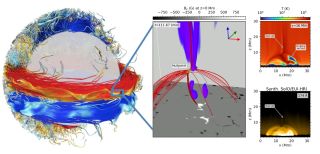Bibcode
Bose, Souvik; Nóbrega-Siverio, Daniel; De Pontieu, Bart; Rouppe van der Voort, Luc
Bibliographical reference
The Astrophysical Journal
Advertised on:
2
2023
Journal
Citations
9
Refereed citations
8
Description
Coronal bright points (CBPs) are sets of small-scale coronal loops, connecting opposite magnetic polarities, primarily characterized by their enhanced extreme-ultraviolet (EUV) and X-ray emission. Being ubiquitous, they are thought to play an important role in heating the solar corona. We aim at characterizing the barely explored chromosphere underneath CBPs, focusing on the related spicular activity and on the effects of small-scale magnetic flux emergence on CBPs. We used high-resolution observations of a CBP in Hβ and Fe I 617.3 nm from the Swedish 1 m Solar Telescope in coordination with the Solar Dynamics Observatory. This work presents the first high-resolution observation of spicules imaged in Hβ. The spicules were automatically detected using advanced image processing techniques, which were applied to the Dopplergrams derived from Hβ. Here we report their abundant occurrence close to the CBP "footpoints" and find that the orientation of such spicules is aligned along the EUV loops, indicating that they constitute a fundamental part of the whole CBP magnetic structure. Spatiotemporal analysis across multiple channels indicates that there are coronal propagating disturbances associated with the studied spicules, producing transient EUV intensity variations of the individual CBP loops. Two small-scale flux emergence episodes appearing below the CBP were analyzed, one of them leading to quiet-Sun Ellerman bombs and enhancing the nearby spicular activity. This paper presents unique evidence of the tight coupling between the lower and upper atmosphere of a CBP, thus helping to unravel the dynamic phenomena underneath CBPs and their impact on the latter.
Related projects

The Whole Sun Project: Untangling the complex physical mechanisms behind our eruptive star and its twins
The Sun is a magnetically active star with violent eruptions that can hit Earth´s magnetosphere and cause important perturbations in our technology-dependent society. The objective of the Whole Sun project is to tackle in a coherent way for the first time key questions in Solar Physics that involve as a whole the solar interior and the atmosphere
Fernando
Moreno Insertis

Numerical Simulation of Astrophysical Processes
Numerical simulation through complex computer codes has been a fundamental tool in physics and technology research for decades. The rapid growth of computing capabilities, coupled with significant advances in numerical mathematics, has made this branch of research accessible to medium-sized research centers, bridging the gap between theoretical and
Daniel Elías
Nóbrega Siverio